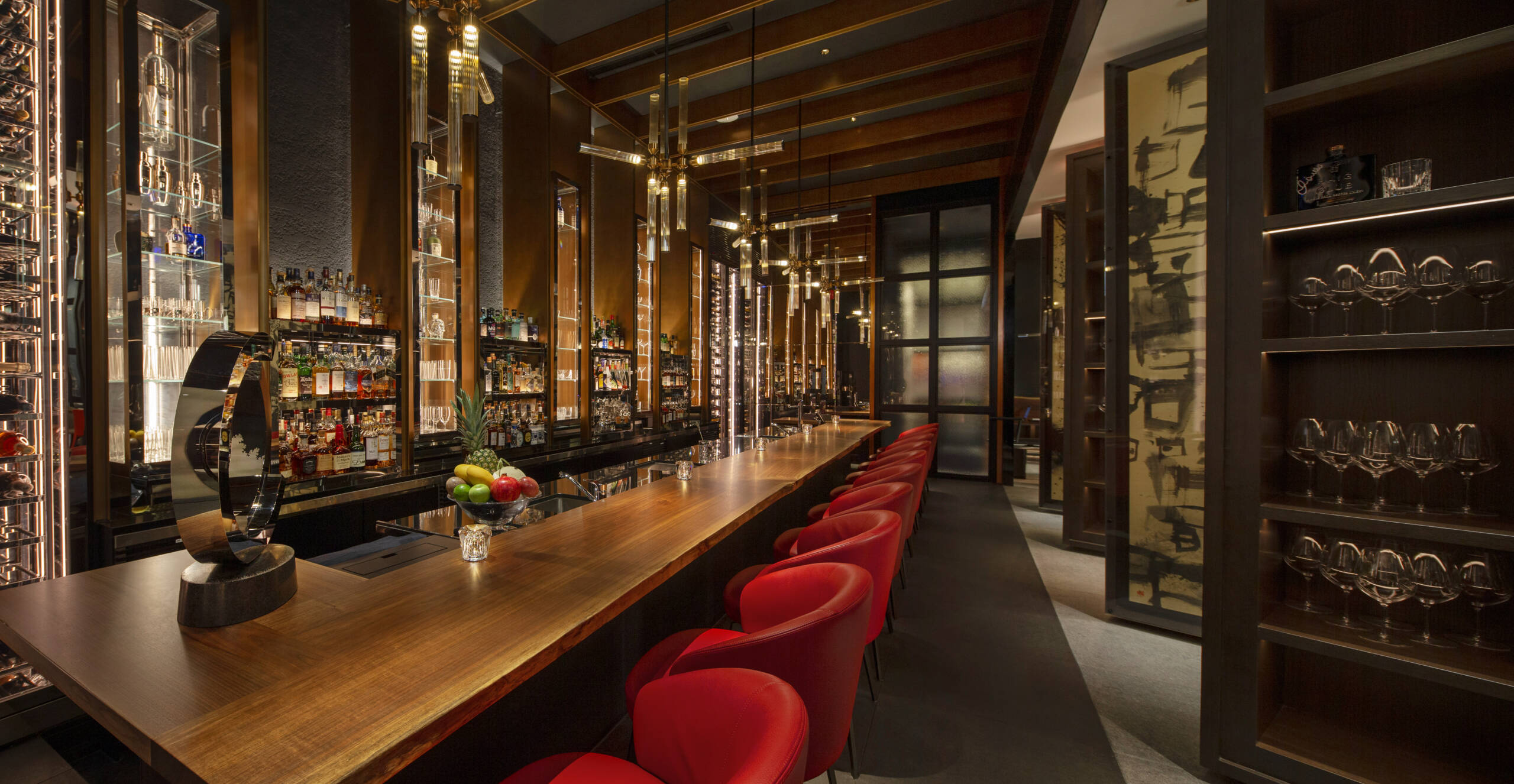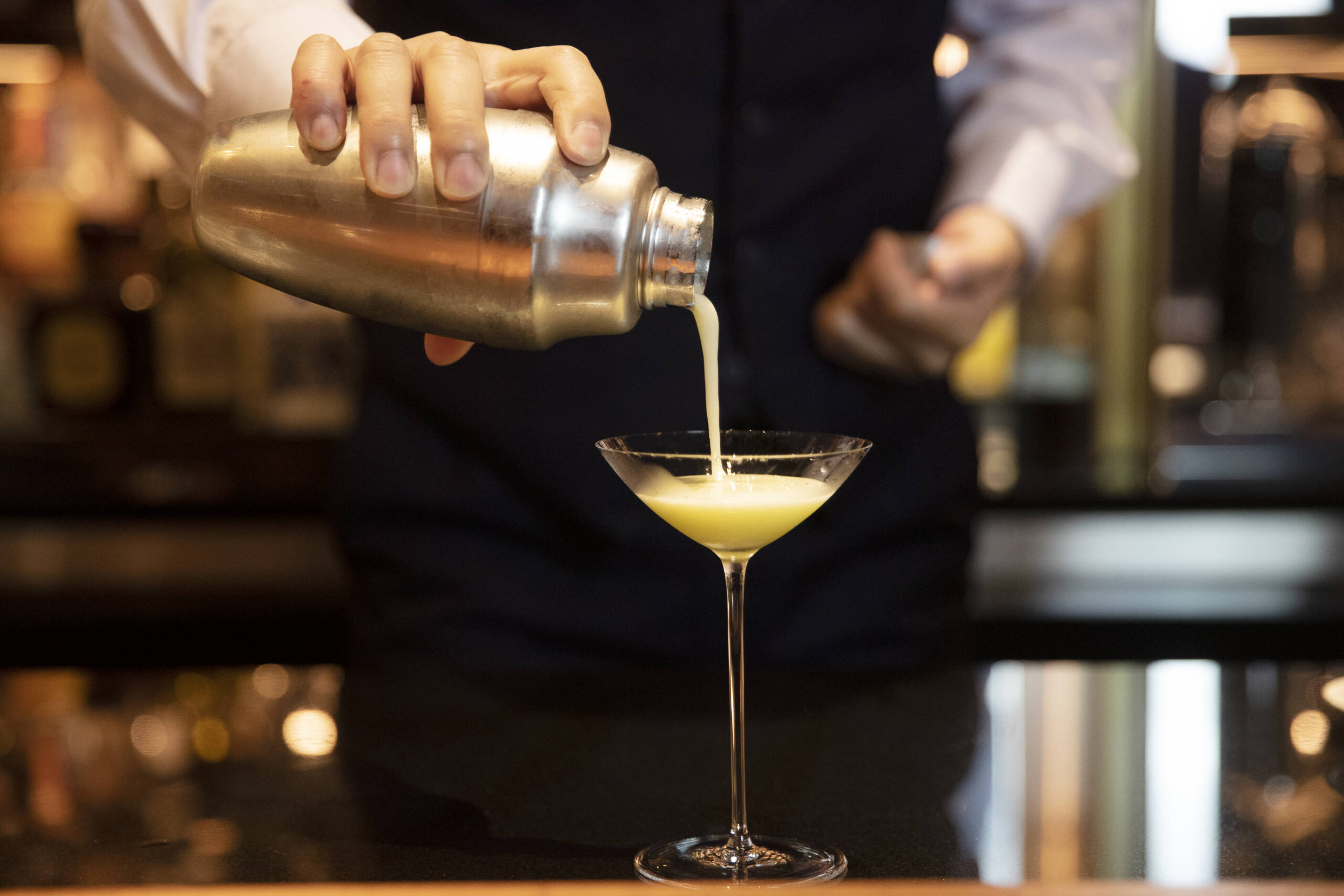
Designed by award-winning Japanese designer Yohei Akao, the dining space integrates natural materials and intricate details, an ode to nature and heritage
Hidden away on the second floor, overlooking hundreds of croupier hands shuffling and dealing in the casino below, is Waku Ghin. LUX inspects the two-Michelin starred Japanese fusion restaurant in Marina Bay shopping centre, Singapore.
Past the suave darkness of the main area, with walls adorned with dark wood and striking art, and a bar teeming with sakés, is a private room, reserved for the chef’s omakase. One sits, cocooned by lighter wood panneling, at a table opposite the chef’s knives and metal, a stove, spices. The chef, in arm’s reach, sharpens his knives. His sous-chef – stick of fresh wasabi in hand, resembling something between a turnip and a thick leek – mashes it to its bright green pulp. The ancient Japanese ritual begins.
The chefs bring out a vast white polystyrene tray, as you see in fishmongers, with fresh fish. Abalone, twitching at the touch, Carabinero prawns, sea urchins, snapper, uroko. But fusion can be flimsy, and non-committal. Would we lose the natural juice of the French Royale oyster to the overpowering salt and spices of ginger and rice vinegar?
Follow LUX on Instagram: luxthemagazine
A chemist’s nose follows these flavours and textures, balanced rather then strewn. As with the marinated prawn in sea urchin – the balance of sweet, almost fruity tastes is careful, rather than overbearing. It’s a visual pleasure, too, its orange body sitting boldly in a black shell.

Experience the new sushi omakase at the private Sushi Room customised for four where diners can get a taste of the finest regional delicacies of Japan
Black truffle and caviar are not attention-seeking but sit subtly alongside, with Oscietra caviar preserved at the very lowest salt-level. The carabinero prawn, vast and dealt with by some sort of saber and a dome, flashed in from of us like an elegant medieval duel. And fear not the fiery wrath of wasabi paste; fresh wasabi is a far milder and more succulent cry. (This makes resoundingly clear the sad fact that most so-called ‘wasabi’ consists solely of turnip and flavouring.) And it prods rather than murders its accompanying red marbled, tender and peppery wagyu sushi, slung elegantly across rice with a dip of citrus soy sauce.
After this we are presented the Amadai Uroko with Maitake Mushroom and Mizuna. The uroko, a type of Japanese tilefish with very thin skin, easier to pincer, puffs up immensely under the heat of the metal stove in front of us, under the expert hand of Executive Chef, Masahiko Inoue. And here is the freshness of the mushrooms; quiet, modest, delicious.
Read more: Rosewood Hong Kong review
Goodbye to the chefs – we are whizzed off to the dessert room, and eased slowly back to reality. One remembers than one is not in a cave in Mount Fuji but, overlooking chandeliers and Gucci, in Singapore’s shopping centre. After many courses, I manage one last one, of Mandarin Granita and White Rum Jelly, luckily unlike the English trifle, where jelly can be a tyrannical dictator. Alongside, the balance of sesame ice-cream and hojicha Chantilly (a type of Japanese green tea, served in puffs) provides a conversation of nut and herb, of temperatures, of colours.

For a more casual night out, the extended bar dining area features Chef Tetsuya’s timeless cuisine
Lest we forget the wines… after a deliciously dry saké at the bar, wines with notes of green apple, honey and lemon lended a staccato crispness, structuring and pierces these flavours, after a deliciously dry saké at the bar. From the Rhone, a delicious Julius Pylon 2021, made specially for Chef Tetsuya, served in a burgundy glass to elevate its spicy aroma, finishing with a glass of Pantelleria, the Sicilian dessert wine which cuts through dessert perfectly with a sort of Scott-Joplin hops of sweetness.
Japanese-born, Sydney-based Chef Tetsuya hinges on untampered fresh produce, Japanese umami and meditteranean herbs. Entering back into Marina Bay Sands, beyond the casino deck, beyond its twinkling lights, to Singapore’s skyline: it has, like Tetsuya’s fusion, that balance of careful, winking acuity.

Pair your experience with an extensive list of handcrafted drinks including bespoke brews from Isojiman and Masuizumi.







Recent Comments